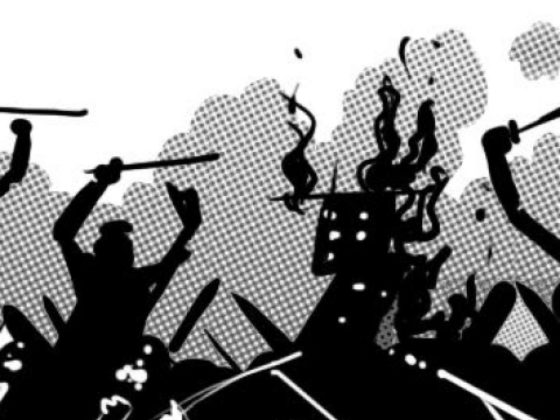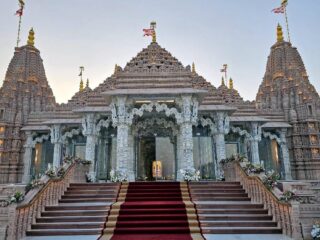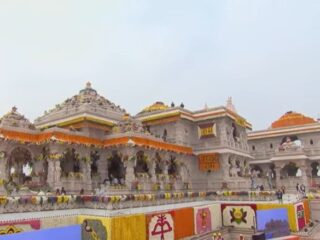CSSS Team: Neha Dabhade, Irfan Engineer, Suraj Nair, Siddhi Pendke[1]
(Secular Perspective February 16-28, 2019)
The preceding two sections of the report examined the communal riots and mob lynching that took place in the year 2018. Violence is more than inflicting physical injury, causing death or damaging property. In this last section, the focus shall be on other forms of violence – symbolic/attitudinal violence and structural violence. This section will cover a gamut of issues, symbolic violence in the form of renaming cities, attitudinal violence in the form of hate speeches and structural violence in the form of patronage, segregation on religious lines and discriminatory legislations.
Simon Fisher et al define violence in broader terms: “violence consists of actions, words, attitudes, structures or systems that cause physical, psychological, social or environmental damage and/or prevent people from reaching their full human potential (Fisher, Smith, Ludin, Williams, Williams, & Abdi, 2000). Physical violence is direct violence and most visible. However, less visible and yet something that causes or motivates or contributes to occurrence of physical violence through violent attitudes and violation of symbols held sacred by a community.
Structural violence can be termed as policies and instruments of the state that discriminate in order to marginalize a community. This is the first time CSSS is studying symbolic and structural violence in its report on communal violence.
Symbolic violence:
‘Symbolic violence… is a show of force and demonstration of power’ showing ‘who can get away with what against whom.’ It functions as an instrument of social control that tends to maintain the existing social order. (Bourdieu)
Certain symbols are used in the public discourse to mean something specific and also give legitimacy to a dominant political thought. There is a binary that’s constructed by the Hindu supremacists where one set of symbols or names are Muslims and thus necessarily inferior and worthy of being Obliterated. And other set of symbols relate to ancient India or its culture which is the standard or goal to uphold. This explains how history of India is explained by the Hindu supremacists who periodize Indian history according to the religion of the rulers and the period of Mughal rule is considered the darkest which spelled an end to the glorious ancient past of India. This thought is reflected today too in the trend of renaming places which is essentially political in nature.
Since 2014, the ruling dispensation has been renaming cities, roads and stations which reflect a historical narrative where Muslims have contributed positively to India. Renaming of a place is not merely an issue of changing a name but an attempt to obliterate the positive contribution of rulers or personalities due to the bias against their religious identity. The aim is to demonize the Muslim community and stigmatize them, seek to inflict punishment on them for being a member of the community. For instance, in Rajasthan, the name of a village called ‘Miyon ka Bara’ was officially changed to ‘Mahesh Nagar’ after residents complained that they are not getting matrimonial matches for their children as the name gave an impression that the village was inhibited by Muslims. It was reported that Rajasthan government had submitted eight proposals to the Home Ministry to change names of places, including changing the name of Ismailpur village to Pichanwa Khurd and Dhani Daroga to Jasawant Pura (Singh, 2018).
In Uttar Pradesh, the government is on an aggressive spree to rename cities. Allahabad was renamed to Prayagraj after renaming Faizabad district’s name to Ayodhya. The name of Mughalserai station was changed to Deen Dayal Upadhyaya Station. There are demands from different BJP legislators to rename some more places. Sangeet Som, Meerut MLA has demanded that Muzaffarnagar be changed to Laxminagar, Jagan Prasad Garg from Agra has demanded that Agra be changed to Agravan or Agrawal claiming that the word Agra was derived from Agarwal community. The argument for the renaming is that it will be keeping with “Indian history and culture”. Sangeet Som said, “All I want to say is that Mughals have worked to destroy our culture, especially destroy Hindutva. We are just trying to save the culture. BJP would move forward in this direction” (Seth, 2018).
In Maharashtra too such demands have surfaced. Shiv Sena and BJP legislators are demanding that Aurangabad to changed to Sambhajinagar, Osmanabad to Dharashiv and Khultabad to Ratnaprabha.
In another instance of symbolic violence, members of Hindu supremacist organization performed puja at 400 year old Mosque in the Taj Mahal Complex. The women who performed the Puja lit dhoti batti and poured ganga jal inside the premises. This puja was performed after the demand to change the name of Taj Mahal, the iconic monument of love to Tejomahalaya (Times of India, 2018). The Muslims have refused to file a complaint in order to maintain peace. This was an attempt to Hinduize the monument and rid it of ‘unIndian’ influences.
Behind all these demands of renaming is the popular narrative about how ancient India was a golden age where India was thriving and the lament that the Muslim rulers spelled ruin and uprooted India culturally and denigrated it. As Apoorvanand argues, this renaming is part of a process of cultural genocide where cultural destruction of a group (Apoorvanand, 2018).
Attitudinal violence:
It appears that there is an increase in the hate speeches reported. The media is also giving them disproportionately large coverage and in a way normalizing hate. And what makes the hate speeches more disturbing is that they are being delivered by persons who are sworn by the Constitution and thus expected to uphold its values. The hate speeches in their objective to demonize the Muslim community also popularize myths and give them currency. The myths include that Muslims are terrorists, Muslims are a demographic time bomb as they practice polygamy. Vande mataram and Bharat mata ki Jai have become sacred articles of faith and also a proof of nationalism.
For example, BJP MLA from Bairia in Ballia district, said, “people who do not chant ‘Bharat Mata ki Jai’ and Vande Mataram are Pakistanis and that such people don’t belong to the country” (Times of India, 2018). BJP MP Kanta Kardam said, “Muslims have been harassing Hindus and one should be cautious about them (Rai, 2018)”. Uttar Pradesh Chief Minister, Yogi Adityanath while trying to paint Mughal Emperor in a poor light said that Aurangzeb forced Kashmiri Pandits to change their religion (Seth, Indian Express, 2018). BJP MP Hari Om Pandey said, “Cases of heinous crime such as rape and murder are rapidly increasing due to the growing Muslim population in India (Times of India, 2018)”. BJP MP Sakshi Maharaj said, “During the Mughal regime, temples were destroyed and damaged in a large numbers and replaced by mosques. Now, even if you razed Delhi’s Jama Masjid, idols of the Hindu deities would be found” (Times of India, 2018).
Union Minister, Giriraj Singh said, “Muslims are descendents of Lord Ram and not of Mughals, so they should support Ram Mandir. If they don’t support the cause of Ram Mandir, they know well that Hindus will hate them. If this hatred increases then Muslims can well imagine the consequences” (Bhatia, 2018). He also believes that Muslims are terrorists and Deoband is a hub of terrorism. He said, “Earlier, Deoband’s name was Deovrant. I do not know what it is about this place that it produces people similar to (Islamic State founder Abu Baqar) Baghdadi and (Pakistan terror ideologue) Hafiz Saeed. This is not a temple of knowledge. It is a hub of terrorism. (Rai S. , 2018)”
There is an attempt to strengthen the myth that Muslims are multiplying rapidly. And thus population figures become a competitive arena. Thus BJP MLA from Khatauli, Vikram Singh Saini said, “Hindus should be allowed to produce more children while there are others who follow the principle of hum panch hamare pachees” (a large Muslim family of one husband, four wives and 20 children) (Indian Express, 2018). Similarly Hari Om Pandey traces the roots of crime in the society to overpopulation of Muslims. He said, “Muslims have three to four marriages and give birth to nine to ten children. The kids are left to roam around and this gives way to lawlessness” (Financial Express, 2018).
Just not hate speeches but violence is reflected in other attitudes too of individuals. A VHP activist tweeted bragging about how he cancelled his Ola cab after realizing that the cab driver was a Muslim. He explained his action by saying that this was his reaction to social media posts allegedly maligning Hindu gods and symbols (Indian Express, 2018).
Hate speeches which malign the image of any religious community in the country and thereby deepening prejudices and incites violence against it should be punished as per the law. However, the trend is quite the opposite where the ruling dispensation is demanding withdrawal of criminal cases against those Hindu supremacist leaders who propagated hate, including Sadhvi Prachi and Sanjeev Balyan. The UP government sought to withdraw 131 cases including 13 of murder, linked to the 2013 communal violence in Muzaffarnagar and Shamli in UP (Sahu, 2018). Overall, there is very little action taken against hate speeches targeting Muslim and Christian community thereby giving it impunity to relentlessly create communal tensions.
Structural violence:
Structural violence is not easily visible because it is embedded in the very systems or structures operating in the society. These can be education systems or legislations etc. Such violence in a way stems out of the state institutions or enjoys its support. In section I, the patronage given to convicted persons involved in mob lynching in Jharkhand were felicitated by Jayant Sinha who is a Union minister (New Indian Express, 2018).
But structural violence takes other forms too. In Delhi, North MCD Boy’s School segregated their Hindu and Muslim students into separate sections (Baruah, 2018). This has a serious implication on the pluralism in the society also communal harmony when children at a young age are given a message that religious identity is a denominator in education and society at large and different religious groups can’t coexist. This segregation is akin to apartheid where racial segregation was a norm.
While the types of violence can’t be watertight, a violent action can be attitudinal/ symbolic and also structural. In a college in Ballia district, Gandhi Mohammad Ali Memorial (GMAM) Inter College, the students were given the freedom to recite Vande Mataram, Jana Gana Mana, Bharat Mata Ki Jai etc. The authorities closed down the college indefinitely (Business Standard, 2018). This incident also points towards the increasing influence and interference of the State in college and universities where differences and dissenting voices are crushed. Apart from political appointments on the important administrative posts, sedition charges are slapped against students who question the dominant political ideology.
Similarly, in Noida, the police ordered that companies would be held liable if their Muslim employees offer Friday ‘namaz’ (prayer) at public parks in the city. This order betrays bias against the Muslims who alone are forbidden to offer prayers in public spaces like parks (New Indian Express, 2018). Laws should be applicable uniformly but in this order only the Muslims were singled out by the police for offering namaz in parks citing the nuisance it creates. This discrimination by the state by coercing the private companies to interfere with the religious lives of their employees is a threat to the freedom of religion and belief.
The resentment towards the “outsiders” and “illegal migrants” in Assam led to the Supreme Court ordering the process of National Register of Citizenship (NRC). There were widespread protests to protect the interests of the indigenous inhabitants of the state against the Bengali Hindus and Muslims who are also assumed to be ‘Bangladeshi migrants’. While the NRC left out the names of 4 million residents causing them hardships and rendering them stateless, the Union government proposed the Citizenship Amendment bill 2016 in the Lok Sabha. The bill seeks to provide Indian citizenship to 6 non-Muslim communities – Hindus, Sikhs, Buddhists, Jains, Christians and Parsis – from Bangladesh, Pakistan and Afghanistan. While clearly this is a discriminatory legislature which cites religion as basis of citizenship and favours other communities over the Muslim community, there were protests in North East India to protect the indigenous communities from the onslaught of migrants that this bill may result in. Scholars and intellectuals from this region who voiced against this bill were slapped with sedition charges. Sedition charges were slapped against Hiren Gohain, Akhil Gogoi, Manjit Mahanta and others. Such discriminatory legislations detrimentally affect the secular fabric of the country.
Conclusion:
All these forms of violence, some direct and visible and others indirect and not so visible, are inter-connected and have to be understood in all its complexity. The violent acts of communal riots and mob lynching didn’t take place in a vacuum but needed a context which was provided by the attitudinal/ symbolic violence and structural violence. Attitudinal or structural violence may be more threatening than the physical violence given its nature to influence mind sets and also gain its legitimacy through long standing structures.
[1] We are thankful to Vanshika Singh and Rajas Kothare for all the research assistance provided
This article is a part of Communal Violence Report 2018. Read Part One here and Part Two here.








